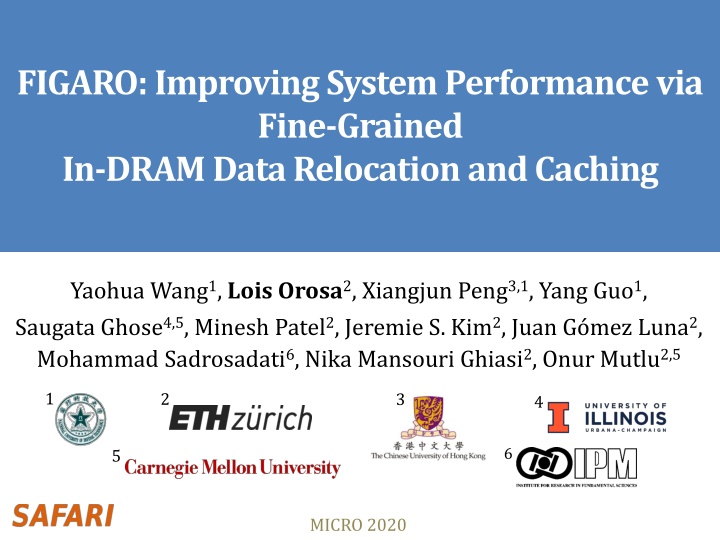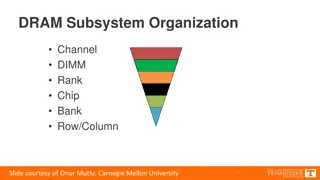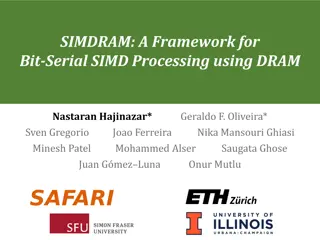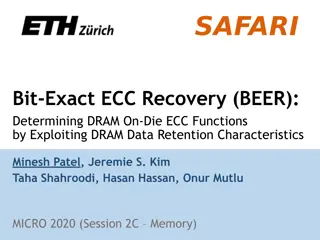Improving System Performance with Fine-Grained In-DRAM Data Relocation and Caching
This study presents FIGARO, a novel approach to reducing DRAM latency through in-DRAM caching. By utilizing fine-grained data relocation and caching, FIGARO optimizes system performance and energy efficiency. The implementation involves leveraging the shared global row buffer in DRAM banks for efficient data relocation and caching of frequently accessed data portions. The experimental results demonstrate a significant improvement in system performance and reduction in DRAM energy consumption.
Uploaded on Feb 25, 2025 | 1 Views
Download Presentation

Please find below an Image/Link to download the presentation.
The content on the website is provided AS IS for your information and personal use only. It may not be sold, licensed, or shared on other websites without obtaining consent from the author.If you encounter any issues during the download, it is possible that the publisher has removed the file from their server.
You are allowed to download the files provided on this website for personal or commercial use, subject to the condition that they are used lawfully. All files are the property of their respective owners.
The content on the website is provided AS IS for your information and personal use only. It may not be sold, licensed, or shared on other websites without obtaining consent from the author.
E N D
Presentation Transcript
FIGARO: Improving System Performance via Fine-Grained In-DRAM Data Relocation and Caching Yaohua Wang1, Lois Orosa2, Xiangjun Peng3,1, Yang Guo1, Saugata Ghose4,5, Minesh Patel2, Jeremie S. Kim2, Juan G mez Luna2, Mohammad Sadrosadati6, Nika Mansouri Ghiasi2, Onur Mutlu2,5 1 2 3 4 6 5 MICRO 2020
Executive Summary Problem: DRAM latency is a performance bottleneck for many applications Goal: Reduce DRAM latency via in-DRAM cache Existing in-DRAM caches: Augment DRAM with small-but-fast regions to implement caches Coarse-grained (i.e., multi-kB) in-DRAM data relocation Relocation latency increases with physical distance between slow and fast regions FIGARO Substrate: Key idea: use the existing shared global row buffer among subarrays within a DRAM bank to provide support for in-DRAM data relocation Fine-grained (i.e., multi-byte) in-DRAM data relocation and distance-independent relocation latency Avoids complex modifications to DRAM by using existing structures FIGCache: Key idea: cache only small, frequently-accessed portions of different DRAM rows in a designated region of DRAM Caches only the parts of each row that are expected to be accessed in the near future Increases row hits by packing more frequently-accessed data into FIGCache Improves system performance by 16.3% on average Reduces DRAM energy by 7.8% on average Conclusion: FIGARO enables fine-grained data relocation in-DRAM at low cost FIGCache outperforms state-of-the-art coarse-grained in-DRAM caches 2
Outline Background Existing In-DRAM Cache Designs FIGARO Substrate FIGCache: Fine-Grained In-DRAM Cache Experimental Methodology Evaluation Conclusion 3
Outline Background Existing In-DRAM Cache Designs FIGARO Substrate FIGCache: Fine-Grained In-DRAM Cache Experimental Methodology Evaluation Conclusion 4
DRAM Organization Subarray Bitline Bank DRAM Cell Wordline Chip I/O . . . Local Row Buffer Global Row Buffer DRAM Subarray DRAM Bank DRAM Chip 5
Bank and Subarray Organization column DRAM row subarray 0 . . . . . . . . . column decoder local row buffer (LRB) sense . . . global bitline amplifier subarray n-1 . . . global row buffer (GRB) to chip I/O logic Each subarray contains 512 2048 rows of DRAM cells DRAM rows areconnected to a local row buffer (LRB) All of the LRBs in a bank are connected to a sharedglobal row buffer (GRB) The GRB is connected to the LRBs using a set of global bitlines The GRB has smaller width (e.g., 8B) than the LRBs (e.g., 1kB) A single column (i.e., a small number of bits) of the LRB is selected using a column decoder to connect to the GRB 6
DRAM Operation DRAM controller issues 4 main memory commands 1) ACTIVATE: activates the DRAM row containing the data Latches the selected DRAM row into the LRB 2) PRECHARGE: prepares all bitlines for a subsequent ACTIVATE command to a different row 3) READ: reads a column of data One column of the LRB is selected using the column decoder The GRB then drives the data to the chip I/O logic 4) WRITE: writes a column of data into DRAM 7
Outline Background Existing In-DRAM Cache Designs FIGARO Substrate FIGCache: Fine-Grained In-DRAM Cache Experimental Methodology Evaluation Conclusion 8
In-DRAM Cache Design Key idea: Introduce heterogeneity in DRAM Common in-DRAM cache organization Slow subarrays Same latency and capacity as regular (i.e., slow) DRAM DRAM Bank Slow Subarray Fast subarrays (shorter bitlines) Fast access latency andsmall capacity Used as in-DRAM cache for hot data Many fast subarrays interleaved among slow subarrays Inclusive cache Fast Subarray (cache) Slow Subarray Data relocation between normal and fast subarrays DRAM row granularity (multi-kilobyte) Relocation latency increases as the physical relocation distance increases Fast Subarray(cache) 9
Inefficiencies of In-DRAM Caches 1) Coarse-grained: Caching an entire row at a time hinders the potential of in-DRAM cache 2) Area overhead and complexity: Many fast subarrays interleaved among normal subarrays 10
Outline Background Existing In-DRAM Cache Designs FIGARO Substrate FIGCache: Fine-Grained In-DRAM Cache Experimental Methodology Evaluation Conclusion 11
Observations and Key Idea Observations: SRC: Subarray A A0 A1 A2 A3 A3 1) All local row buffers (LRBs) in a bank are connected to a single shared global row buffer (GRB) A4 A5 A6 A7 Local Row Buffer (LRB) 2) The GRB has smaller width (e.g., 8B) than the LRBs (e.g., 1kB) 1kB DST: Subarray B GRB B0 B1 B2 B3 Key Idea: use the existing shared GRB among subarrays within a DRAM bank to perform fine-grained in-DRAM data relocation 8B B4 B5 B6 B7 Local Row Buffer (LRB) 12
FIGARO Overview FIGARO: Fine-Grained In-DRAM Data Relocation Substrate Relocates data across subarrays within a bank Column granularity within a chip Cache-block granularity within a rank New RELOC command to relocate data between LRBs of different subarrays via the GRB 13
Transferring Data via FIGARO ACTIVATEsubarray A Copies data from row to LRB 1 SRC: Subarray A column decoder A0 A1 A2 A3 A0 A1 A2 A3 A0 A1 A2 A3 A4 A5 A6 A7 LRB 2 RELOCA col 3 B col 1 A0 A1 A2 A3 A0 A1 A2 3 Selects Column 3 in Subarray A Loads A3 into the GRB Selects Column 1 in Subarray B DST: Subarray B GRB A3 B0 B0 A3 B2 B1 B2 B3 B3 B4 B5 B6 B7 ACTIVATEsubarray B Overwrites A3 in column 1 3 B0 A3 B2 B3 A3 1 14
Key Features of FIGARO Fine-grained: column/cache-block level data relocation Distance-independent latency The relocation latency depends on the length of global bitline Similar to the latency of read/write commands Low overhead Additional column address MUX, row address MUX, and row address latch per subarray 0.3% DRAM chip area overhead Low latency and low energy consumption Low latency (63.5ns) to relocate one column Two ACTIVATEs, one RELOC, and one PRECHARGE commands Low energy consumption (0.03uJ) to relocate one column 15
More FIGARO Details in the Paper Enabling Unaligned Data Relocation Circuit-level Operation and Timing SPICE Simulations Other Use Cases for FIGARO 16
Outline Background Existing In-DRAM Cache Designs FIGARO Substrate FIGCache: Fine-Grained In-DRAM Cache Experimental Methodology Evaluation Conclusion 17
FIGCache Overview Key idea: Cache only small, frequently-accessed portions of different DRAM rowsin a designated region of DRAM FIGCache (Fine-Grained In-DRAM Cache) Uses FIGARO to relocate data into and out of the cache at the fine granularity of a row segment Avoids the need for a large number of fast (yet low capacity) subarrays interleaved among slow subarrays Increases row buffer hit rate FIGCache Tag Store (FTS) Stores information about which row segments are currently cached Placed in the memory controller FIGCache In-DRAM Cache Designs Using 1) fast subarrays, 2)slow subarrays, or 3) fast rows in a subarray 18
Benefits of FIGCache Fine-grained (cache-block) caching granularity Low area overhead and manufacturing complexity 19
FIGCache Tag Store (FTS) The memory controller stores information about which row segments are in cache Fully associative cache FIGCache Tag Store (FTS) Bank 0 Bank 1 Bank n-1 Tag(Original Address) Slot 0 1. . . 511 V D Benefit . . . . . . . . . . . . . . . . . . . . . . . . . . . . . . . . . . . . . . . Benefit: Benefit counter (used for cache replacement) 20
Insertion and Replacement FIGCache insertion policy Insert-any-miss: every FIGCache miss triggers a row segment relocationinto the cache FIGCachereplacement policy 1) Sum all Benefit values from all segments of the row 2) The row with least Benefit is selected for eviction Row granularity replacement We experimentally find that FIGCache insertion and replacement policies are rather effective 21
FIGCache Designs FIGCache using Fast Subarrays FIGCache using Slow Subarrays (i.e., existing DRAM chips) DRAM Bank DRAM Bank Slow Subarray Slow Subarray Slow Subarray Slow Subarray Fast Subarray(cache) Reserved Row (cache) 22
Outline Background Existing In-DRAM Cache Designs FIGARO Substrate FIGCache: Fine-Grained In-DRAM Cache Experimental Methodology Evaluation Conclusion 23
Experimental Methodology Simulator Ramulator open-source DRAM simulator [Kim+, CAL 15] [https://github.com/CMU-SAFARI/ramulator] Energy model: McPAT, CACTI, Orion 3.0, and DRAMPower System configuration 8 cores, 3-wide issue, 256-entry instruction window L1 4-way 64KB, L2 8-way 256KB, L3 LLC 16-way 2MB per core DRAM DDR4 800MHz bus frequency FIGCache default parameters Row segment size: 1/8th of a DRAM row (16 cache blocks) Fast subarray reduces tRCD by 45.5%, tRP by 38.2%, and tRAS by 62.9% In-DRAM cache size: 64 rows per bank Workloads 20 eight-core multiprogrammed workloads from SPEC CPU2006, TPC, BioBench, Memory Scheduling Championship 24
Comparison Points Baseline: conventional DDR4 DRAM LISA-VILLA: State-of-the-art in-DRAM Cache [Chang+, HPCA 16] FIGCache-slow: Our in-DRAM cache with cache rows stored in slow subarrays FIGCache-fast: Our in-DRAM cache with cache rows stored in fast subarrays FIGCache-ideal: An unrealistic version of FIGCache-Fast where the row segment relocation latency is zero LL-DRAM: System where all subarrays are fast 25
Outline Background Existing In-DRAM Cache Designs FIGARO Substrate FIGCache: Fine-Grained In-DRAM Cache Experimental Methodology Evaluation Conclusion 26
Multicore System Performance 27.1% Memory intensity 12.9% Average across all workloads: 16.3% The benefits of FIGCache-Fast and FIGCache-Slow increase as workload memory intensity increases Both FIGCache-slow and FIGCache-fast outperform LISA-VILLA FIGCache-Fast approaches the ideal performance improvement of both FIGCache-Ideal and LL-DRAM 27
Multicore System Energy Savings -14% FIGCache-Slow and FIGCache- Fast consume less energy than Base Energy reduction comes from: 1) Improved DRAM row buffer hit rate 2) Reduced execution time that saves static energy across each component Memory intensity FIGCache is effective at reducing system energy consumption 28
FIGCache Replacement Policies RowBenefit: FIGCache replacement policy +4.1% SegmentBenefit: traditional benefit-based policy [Lee+,HPCA 13] Observations: 1) FIGCache outperforms Base with all replacement policies 2) RowBenefit outperforms all the other policies RowBenefit replacement policy is effective at capturing temporal locality 29
Different Row Segment Sizes FIGCache 1KB is the best configuration Performance highly depends on the row segment size 30
More Results in the Paper More Detailed Results Single-core Workloads In-DRAM Cache Hit Rate DRAM Row Buffer Hit Rate Performance with Different Row Segment Insertion Thresholds Performance with Different Cache Capacities 31
Outline Background Existing In-DRAM Cache Designs FIGARO Substrate FIGCache: Fine-Grained In-DRAM Cache Experimental Methodology Evaluation Conclusion 32
Executive Summary Problem: DRAM latency is a performance bottleneck for many applications Goal: Reduce DRAM latency via in-DRAM cache Existing in-DRAM caches: Augment DRAM with small-but-fast regions to implement caches Coarse-grained (i.e., multi-kB) in-DRAM data relocation Relocation latency increases with physical distance between slow and fast regions FIGARO Substrate: Key idea: use the existing shared global row buffer among subarrays within a DRAM bank to provide support for in-DRAM data relocation Fine-grained (i.e., multi-byte) in-DRAM data relocation and distance-independent relocation latency Avoids complex modifications to DRAM by using existing structures FIGCache: Key idea: cache only small, frequently-accessed portions of different DRAM rows in a designated region of DRAM Caches only the parts of each row that are expected to be accessed in the near future Increases row hits by packing more frequently-accessed data into FIGCache Improves system performance by 16.3% on average Reduces DRAM energy by 7.8% on average Conclusion: FIGARO enables fine-grained data relocation in-DRAM at low cost FIGCache outperforms state-of-the-art coarse-grained in-DRAM caches 33
FIGARO: Improving System Performance via Fine-Grained In-DRAM Data Relocation and Caching Yaohua Wang1, Lois Orosa2, Xiangjun Peng3,1, Yang Guo1, Saugata Ghose4,5, Minesh Patel2, Jeremie S. Kim2, Juan G mez Luna2, Mohammad Sadrosadati6, Nika Mansouri Ghiasi2, Onur Mutlu2,5 1 2 3 4 6 5 MICRO 2020






















